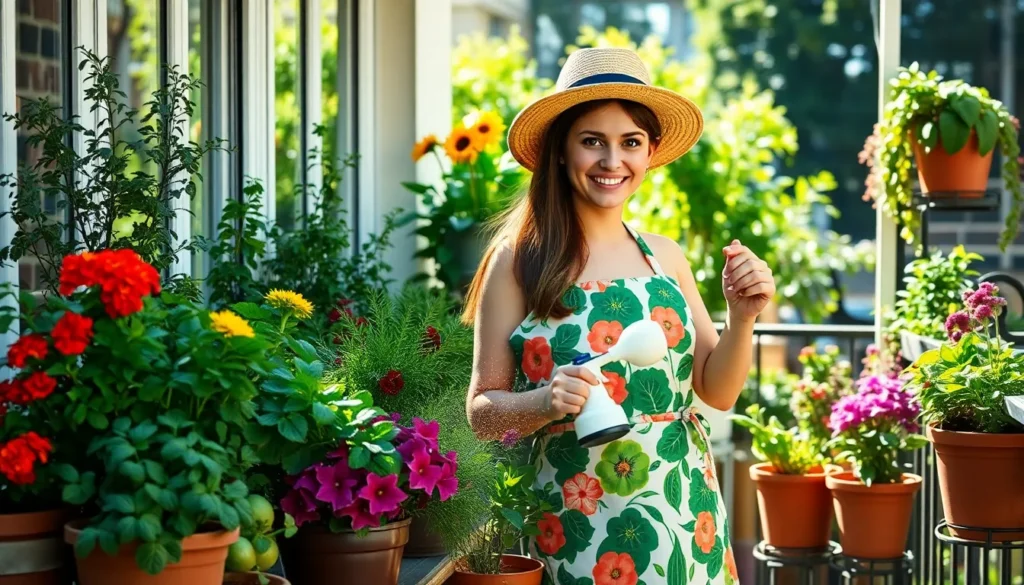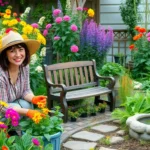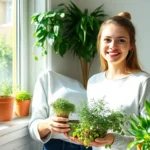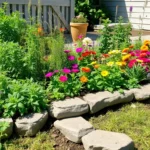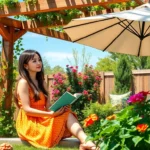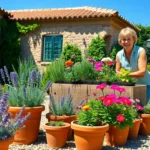Container gardening transforms any space into a thriving green oasis, whether you’re working with a tiny apartment balcony or a sprawling backyard patio. We’ve discovered that the beauty of container gardens lies in their incredible versatility – you can grow everything from vibrant flowers to fresh herbs and vegetables in pots, planters, and creative containers you never imagined could hold plants.
What makes container gardening so appealing is the complete control you have over your growing environment. We can easily move plants to catch the perfect amount of sunlight, protect them from harsh weather, and even bring tender plants indoors when seasons change. Plus, container gardens require less weeding, offer better pest control, and let you garden regardless of your soil quality.
Whether you’re a complete beginner or looking to expand your gardening horizons, we’ll show you innovative container garden ideas that’ll maximize your space and boost your growing success.
Choose the Right Containers for Your Garden Space
Container selection impacts your garden’s success more than any other single factor. We’ll explore essential considerations that transform ordinary spaces into thriving container gardens.
Consider Size and Drainage Requirements
Size matters significantly when selecting containers for your garden space. Plants need adequate root space to develop properly, with most vegetables requiring containers at least 12 inches deep and herbs thriving in 6 to 8 inch depths. Tomatoes demand extra large containers measuring 20 gallons or more, while lettuce and shallow rooted plants flourish in containers as small as 4 inches deep.
Drainage holes prevent waterlogged soil that kills plant roots through oxygen deprivation. We recommend containers with multiple drainage holes spaced every 6 to 8 inches across the bottom. Elevated containers on pot feet or blocks improve drainage further by allowing excess water to escape completely.
Volume calculations help determine appropriate container sizes for different plant types. A single pepper plant needs 5 gallons of soil space, while bush beans require only 2 to 3 gallons per plant. Root vegetables like carrots need containers at least 12 inches deep, whereas spreading plants like squash demand 20 gallon containers minimum.
Select Weather-Resistant Materials
Durability determines how long your containers withstand outdoor conditions year after year. Fiberglass containers resist cracking in freeze thaw cycles and maintain their appearance for decades with minimal maintenance. Ceramic and terracotta pots offer excellent breathability but crack easily when temperatures drop below freezing.
Plastic containers provide the most affordable weather resistant option for beginning gardeners. High density polyethylene containers resist UV damage and temperature fluctuations while remaining lightweight for easy repositioning. Recycled plastic containers offer environmental benefits and perform equally well as new options.
Metal containers require proper treatment to prevent rust and heat buildup that damages plant roots. Galvanized steel planters resist corrosion naturally, while powder coated aluminum containers offer superior heat reflection. We suggest avoiding untreated metal containers in climates with high humidity or frequent rainfall.
Match Container Style to Your Aesthetic
Modern minimalist designs complement contemporary outdoor spaces with clean lines and neutral colors. Rectangular fiberglass planters in white, gray, or black create sophisticated container gardens that blend seamlessly with modern architecture. Geometric shapes like cubes and cylinders add visual interest without overwhelming the overall design.
Traditional garden styles benefit from classic materials like aged terracotta, weathered wood, or stone textured containers. Decorative urns and ornate planters enhance formal garden settings, while rustic wooden barrels and vintage metal containers suit cottage garden aesthetics perfectly.
Color coordination creates visual harmony between containers and surrounding industry elements. Earth tones like browns, tans, and deep greens blend naturally with most garden settings, while bright colors like cobalt blue or terra cotta orange create striking focal points. We recommend limiting container colors to two or three complementary shades for the most cohesive appearance.
Create a Stunning Herb Garden in Small Spaces

Building on our container selection expertise, we’ll explore how herbs transform compact areas into aromatic, functional gardens. Mixed herb planters offer the perfect solution for balconies and patios, combining basil, rosemary, and thyme in single large containers for visually appealing arrangements.
Design a Kitchen Window Herb Collection
Window box herb gardens provide immediate access to fresh seasonings right outside your kitchen window. Install these space-efficient planters to grow parsley, cilantro, and dill within arm’s reach of your cooking space.
Tiered window sill planters maximize vertical space while adding decorative elements to your kitchen interior. Stack multiple levels of compact containers to accommodate various herb varieties without overwhelming your available surface area. Position frequently used herbs like basil and oregano on easily accessible tiers for convenient harvesting during meal preparation.
Build a Tiered Herb Garden Tower
Vertical gardening structures allow multiple herb varieties to flourish in minimal floor space using wooden or metal tiered planters. Construct these tower systems to accommodate different root depths, placing shallow-rooted herbs like chives on upper levels and deeper-rooted varieties like sage below.
Repetition and contrast techniques create striking visual displays by alternating similar containers with different herb textures and colors. Arrange Mediterranean herbs with silvery foliage alongside vibrant green culinary varieties to establish ever-changing focal points in your small space garden.
Establish a Rolling Herb Cart for Mobility
Mobile herb gardens on wheeled frames offer ultimate flexibility for following sunlight patterns throughout your space. Create these rolling systems using wooden or metal frameworks that accommodate various container sizes while maintaining stability during transport.
Versatile planter combinations mixing rustic and modern styles add character to mobile herb carts. Blend weathered terra cotta pots with sleek metal containers to create eclectic displays that complement both traditional and contemporary outdoor aesthetics.
Design Beautiful Flower Container Arrangements

Creating stunning flower displays requires thoughtful planning and strategic design choices. We’ll explore proven techniques that transform ordinary containers into captivating garden focal points.
Plan Colorful Seasonal Displays
Seasonal plant selection drives successful container arrangements that maintain visual appeal throughout the year. Caladiums and ferns create lush summer displays while succulents thrive in hot climate conditions, providing drought-resistant beauty when temperatures soar.
Temperature-appropriate varieties ensure your arrangements flourish rather than struggle against seasonal challenges. Spring containers benefit from cool-weather annuals like pansies and snapdragons, while fall displays shine with chrysanthemums and ornamental kale.
Color coordination across multiple containers creates cohesive outdoor living spaces that feel intentionally designed. Warm tones like oranges and reds work beautifully for autumn displays, while cool blues and purples provide refreshing summer arrangements.
Repetition techniques using similar plants in smaller pots tie together larger arrangements, creating visual harmony throughout your container garden space. This approach prevents scattered, chaotic looks while maintaining individual container character.
Combine Textures and Heights for Visual Interest
Textural variety adds depth and sophistication to flower container arrangements through strategic material combinations. Smooth stones, decorative pebbles, and textured ground covers create visual contrast against soft flower petals and foliage.
Height variation transforms flat container displays into ever-changing three-dimensional gardens that capture attention from multiple angles. Tiered plant stands and decorative risers elevate certain planters, creating layers that guide the eye through your arrangement.
Plant structure mixing follows the proven thriller, filler, spiller concept that professional designers rely on for balanced compositions. Tall plants serve as focal points, mid-sized varieties fill empty spaces, and trailing plants soften container edges with cascading growth.
Container diversity using different planter heights, sizes, and shapes prevents monotonous displays while maintaining visual cohesion. Odd-numbered groupings of three or five containers create naturally pleasing arrangements that feel balanced rather than forced.
Select Long-Blooming Varieties for Extended Beauty
Extended flowering periods maximize your container garden investment by choosing varieties that perform consistently over several months. Polka rose and yellow verbena provide continuous blooms throughout their growing seasons, reducing the need for frequent replanting.
Strategic plant placement ensures each variety receives appropriate lighting conditions for optimal flowering performance. Sun-loving bloomers need direct sunlight exposure while shade-tolerant flowers thrive in protected locations with filtered light.
Succession planting extends seasonal interest by combining early, mid, and late-blooming varieties within single container arrangements. This technique provides continuous color transitions as different plants reach their peak flowering periods.
Weather-resistant selections maintain container beauty even though challenging outdoor conditions like wind, rain, and temperature fluctuations. Hardy annuals and perennials adapted to your local climate provide reliable performance with minimal maintenance requirements.
Grow Fresh Vegetables in Limited Garden Areas
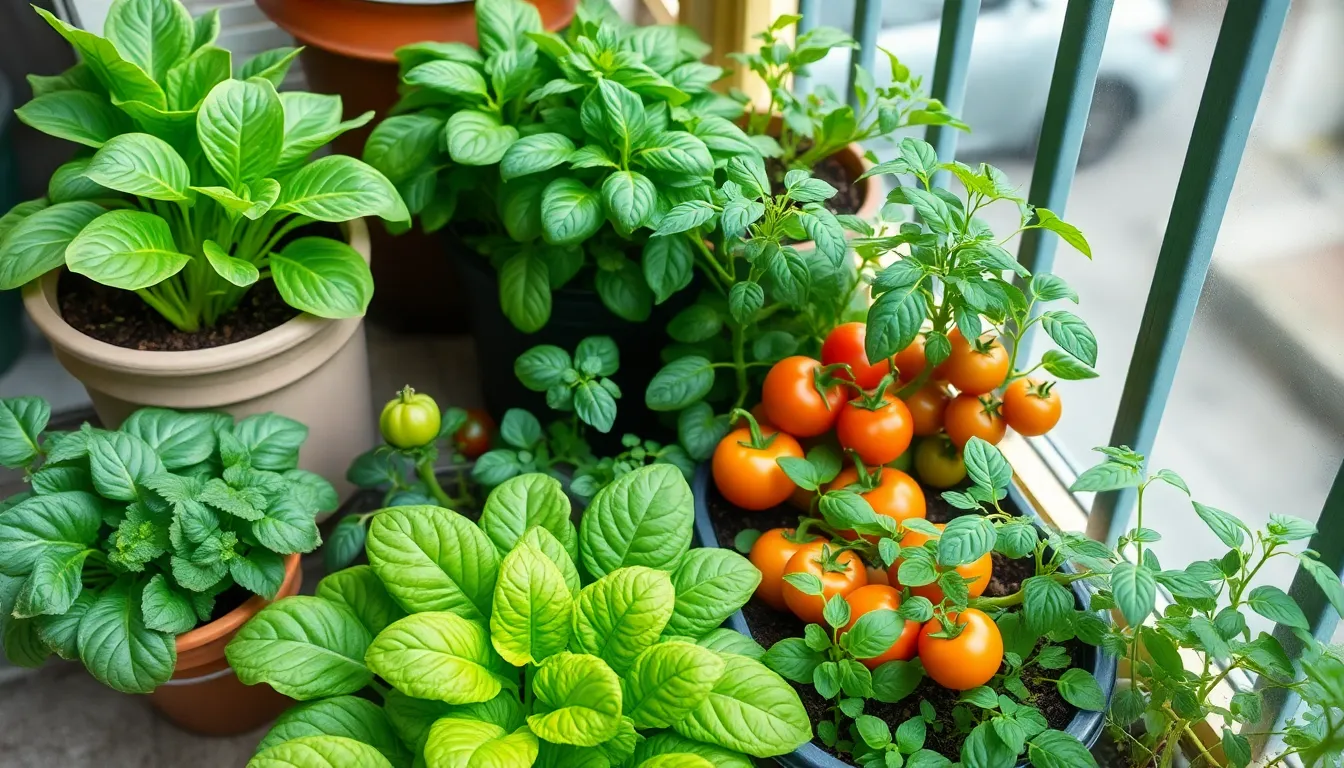
Container vegetable gardening transforms small spaces into productive growing areas that deliver fresh produce throughout the season.
Start with Easy-to-Grow Leafy Greens
Leafy greens offer the perfect entry point for container vegetable gardening since they adapt well to confined spaces. We recommend starting with lettuce, spinach, and arugula because these varieties thrive in containers as small as 2 gallons. These quick-growing vegetables produce multiple harvests from a single planting, maximizing your garden’s productivity.
Space requirements for leafy greens remain minimal compared to other vegetables, making them ideal for balconies and small patios. Spinach tolerates cooler temperatures and partial shade, while arugula adds a peppery flavor that enhances salads and sandwiches. Lettuce varieties like buttercrunch and romaine grow efficiently in shallow containers, providing continuous harvests when we practice succession planting every two weeks.
Cultivate Compact Tomato and Pepper Varieties
Compact tomato and pepper varieties deliver full-sized flavor in smaller packages that suit container growing perfectly. We suggest choosing determinate tomato types like ‘Patio Princess’ or ‘Tiny Tim’ because they stay manageable while producing abundant fruit. These varieties require containers at least 5 gallons in size to accommodate their root systems properly.
Pepper plants like ‘Lunchbox’ and ‘Mini Belle’ varieties produce colorful harvests in containers ranging from 3 to 5 gallons. Compact varieties eliminate the need for extensive staking systems while delivering the same nutritional benefits as their larger counterparts. These plants respond well to regular feeding and consistent watering schedules that container growing allows us to control precisely.
Maximize Space with Vertical Vegetable Gardens
Vertical gardening techniques multiply our growing capacity by utilizing upward space that traditional gardens leave unused. We can install trellises and wall-mounted planters to support vining vegetables like summer squash and cucumbers effectively. This method creates dramatic visual displays while producing substantial harvests in minimal floor space.
Stackable planter systems and tower gardens allow us to grow multiple vegetable types in the same footprint as a single traditional container. Summer squash varieties like ‘Eight Ball’ and ‘Pattypan’ work well with vertical supports, while cucumber varieties such as ‘Spacemaster’ and ‘Bush Champion’ stay compact yet productive. These vertical arrangements improve air circulation around plants, reducing disease problems common in dense plantings.
Build Themed Container Garden Collections

Transform your container garden into a cohesive visual story by developing collections around exact themes. These curated displays create instant impact while allowing you to explore different gardening styles and plant combinations.
Develop a Mediterranean-Inspired Garden
Mediterranean themed containers bring warmth and rustic charm to any outdoor space. We recommend starting with terra cotta pots as your foundation, since their porous nature and earthy tones perfectly complement this theme’s aesthetic.
Plant Selection: Incorporate Mediterranean plants like trailing rosemary (‘Wilma’s Gold’), succulents such as ‘Zwartkop’ aeonium, and aromatic herbs like oregano and thyme. These drought tolerant varieties thrive in container environments while providing both visual appeal and culinary benefits.
Container Design: Focus on warm, earthy tones using terra cotta pots to create an authentic Mediterranean ambiance. Layer different sized containers at varying heights to mimic the terraced landscapes of coastal Mediterranean regions.
Create a Japanese Zen Container Display
Japanese inspired container gardens emphasize simplicity and natural beauty through carefully chosen elements. We suggest embracing the minimalist philosophy that defines traditional Japanese garden design.
Minimalist Approach: Incorporate plants with simple, elegant shapes like bamboo or Japanese maple to create clean lines and peaceful focal points. Select specimens that showcase natural growth patterns rather than heavily pruned or artificial forms.
Serene Colors: Use muted colors and incorporate moss or gravel for a natural, peaceful look that promotes contemplation. Arrange containers asymmetrically to follow Japanese design principles while maintaining visual balance through thoughtful placement.
Establish a Native Plant Container Network
Native plant containers create sustainable, low maintenance displays that support local wildlife while celebrating regional flora. We recommend researching plants indigenous to your exact area for the most successful results.
Native Plant Selection: Choose plants native to your region, such as coral bells and cushion bush for a winter wonderland effect. These adapted species require less water and fertilizer while attracting beneficial insects and birds to your container garden.
Diverse Textures: Combine different textures like succulents, grasses, or flowering plants to create a vibrant network that changes throughout the seasons. Group containers of varying sizes to replicate natural plant communities found in your local industry.
Incorporate Creative Recycled Container Options

We can transform everyday items and forgotten treasures into stunning planters that add personality to our container gardens. Recycling common household objects, furniture pieces, and industrial materials creates unique growing spaces while reducing waste.
Transform Household Items into Planters
Plastic bottles become perfect mini planters when we cut the bottom sections off and use them for herbs like basil or small succulents. These lightweight containers work exceptionally well for starting seedlings or creating hanging displays.
Old boots offer charming rustic planters that work beautifully for small plants such as herbs, pansies, or trailing ivy. Rain boots and work boots provide excellent drainage options when we drill a few holes in the soles.
Kitchen colanders transform into ideal hanging planters for cascading plants like ferns, ivy, or strawberry plants. The built-in drainage holes eliminate waterlogging concerns while creating attractive suspended displays.
Tin cans serve as excellent starter containers for herbs and small flowers when we remove labels and drill drainage holes. Large coffee cans work particularly well for deeper-rooted plants like tomatoes or peppers.
Teapots and kettles create whimsical planters that add vintage charm to our gardens, especially when filled with colorful annuals or trailing succulents.
Repurpose Old Furniture for Garden Use
Old dressers become multi-level planting stations when we remove drawers and use the compartments for different plant varieties. This approach creates organized growing spaces with natural separation between plants.
Wooden chairs serve as creative planter holders when we remove seats and place containers in the openings, or use them as supports for climbing plants like morning glories.
Tables transform into elevated garden displays that bring plants closer to eye level while providing underneath storage for gardening supplies.
Ladder shelves offer vertical growing answers that maximize space while creating interesting height variations in our container arrangements.
Convert Industrial Items into Unique Containers
Metal pallets provide modern industrial-style planters that work exceptionally well for contemporary garden designs and larger plants requiring substantial root space.
Old tires stack into tiered planters that create dramatic vertical displays while recycling materials that would otherwise fill landfills. We can paint them in coordinating colors to match our garden themes.
Galvanized buckets add rustic charm to our gardens while providing excellent durability for outdoor conditions, making them perfect for plants like fountain grass or large succulents.
Wheelbarrows become mobile planters that we can move to follow sunlight patterns throughout the day, ideal for heavy plants or seasonal displays.
Wire baskets lined with coconut fiber create attractive hanging or standing planters that provide excellent drainage while maintaining a natural appearance.
Master Seasonal Container Garden Transitions
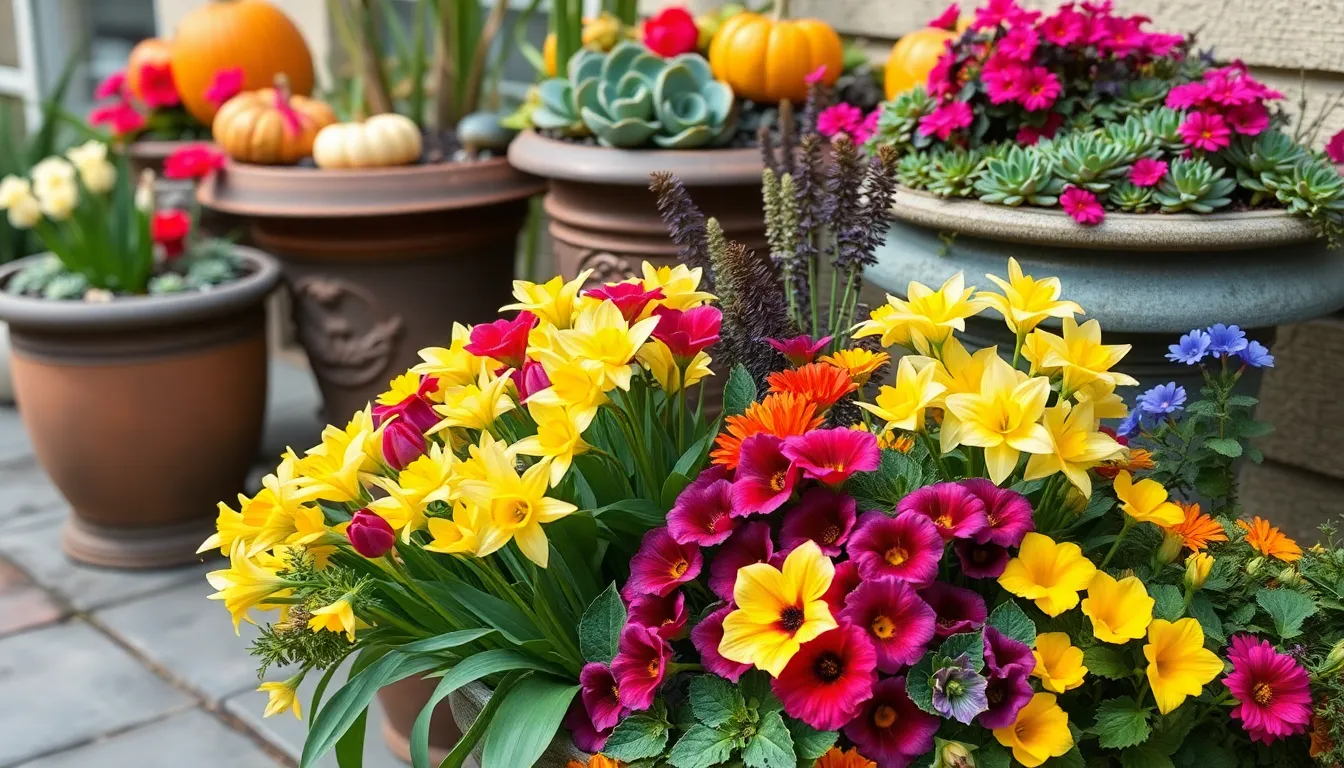
Transitioning our container gardens through the seasons ensures we maintain year-round beauty and interest. Strategic planning allows us to create continuous displays that evolve naturally with changing weather patterns.
Plan Spring Bulb Container Displays
Layered bulb planters offer the most effective approach to extending spring blooming periods through strategic depth placement. We recommend using the “lasagna-style” layering technique, starting with tulips at the bottom, adding daffodils in the middle layer, then crocuses near the surface, and finishing with pansies on top for continuous blooms throughout spring.
Pre-planting in nursery pots provides superior winter protection while maintaining flexibility for spring displays. Plant bulbs in plastic nursery pots during fall, overwinter them under protective mulch, then transfer the established plants to decorative planters when spring arrives. This method ensures our bulbs survive harsh winter conditions while giving us complete control over final container arrangements.
Succession planting maximizes our spring color impact by staggering planting times for extended blooming periods. We can plant early varieties like snowdrops and winter aconite, followed by mid-season daffodils and tulips, then finish with late bloomers like alliums and grape hyacinths.
Design Summer Heat-Tolerant Arrangements
Succulent combinations thrive in summer’s intense heat while requiring minimal maintenance throughout the growing season. We combine varieties like echeveria, sedum, and jade plants in well-draining containers to create stunning architectural displays that withstand temperature extremes.
Colorful annual selections including lantana and zinnias provide vibrant summer displays that flourish in warm temperatures. These heat-loving plants deliver continuous blooms from early summer through fall, making them ideal foundation plants for our seasonal containers.
Drought-resistant perennials like lavender, ornamental grasses, and Mediterranean herbs create sustainable summer arrangements that conserve water. We group these plants according to their water needs, placing the most drought-tolerant varieties in the center and slightly more water-dependent plants around the edges.
Create Autumn and Winter Interest Containers
Fall decoration integration transforms our containers into seasonal showcases using asters and chrysanthemums as flowering foundations. We incorporate decorative elements such as small pumpkins, gourds, and dried corn stalks to create authentic autumn displays that celebrate the harvest season.
Winter evergreen arrangements provide structure and color during the dormant season using holly branches, pine boughs, and winter berries. Adding seasonal ornaments or string lights enhances these displays, creating focal points that brighten dark winter days.
Textural winter elements including ornamental kale, winter pansies, and colorful stems create visual interest when most plants are dormant. We combine these living elements with natural materials like pinecones, bare branches, and seed pods to build containers that remain attractive throughout winter months.
Solve Common Container Gardening Challenges
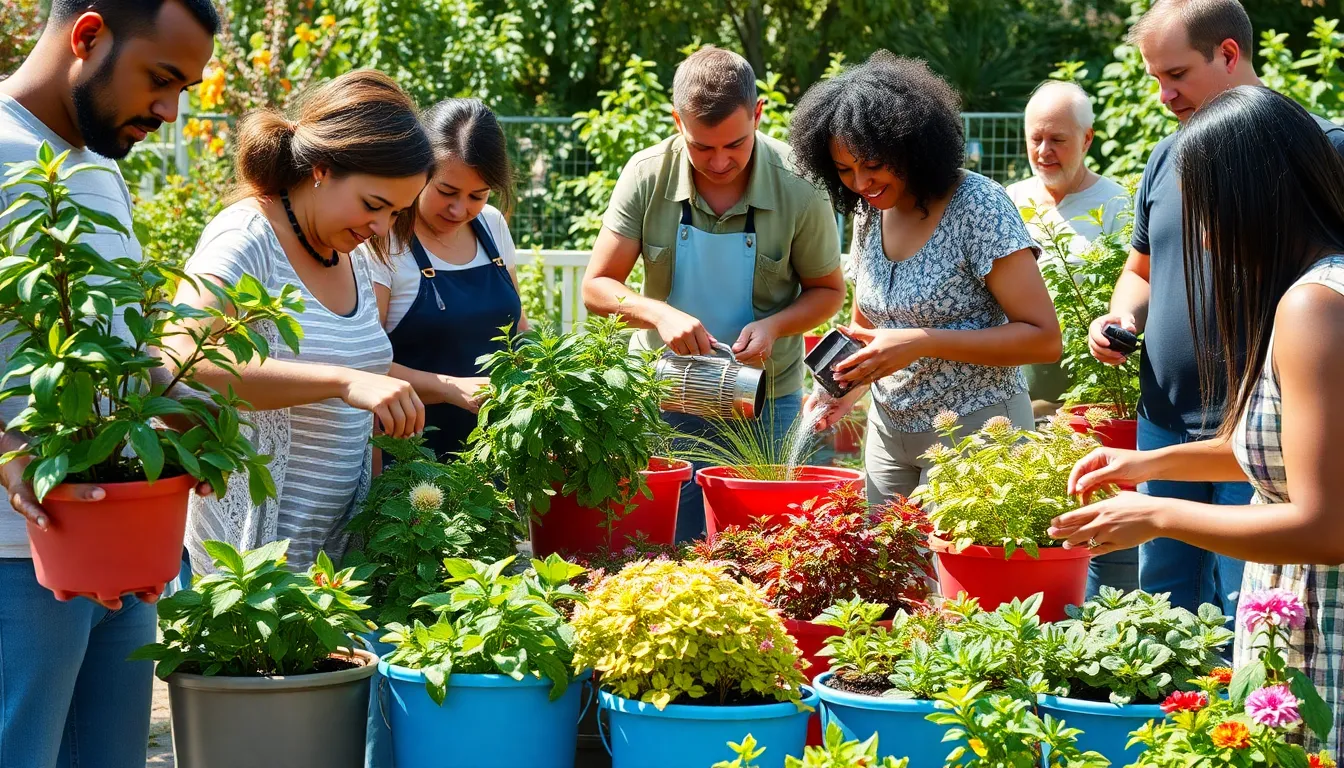
Container gardening presents unique obstacles that we can overcome with proper planning and techniques. Understanding these challenges helps us create thriving container gardens that produce healthy plants year-round.
Address Watering and Drainage Issues
Drainage holes form the foundation of successful container gardening. We must select containers with existing drainage holes or create them ourselves to prevent waterlogged soil conditions. Water should flow freely from the bottom of each pot when we water thoroughly.
Quality drainage materials enhance water flow without adding unnecessary weight. Modular drainage mats and screens prevent soil from clogging holes while offering lightweight answers. These materials work better than traditional gravel or rocks, which actually worsen drainage by creating water pockets.
Thorough watering techniques ensure proper soil saturation throughout the container. We should water until we see water flowing from the drainage holes beneath each pot. This method guarantees that moisture reaches all root zones and prevents dry pockets from forming in the soil.
Perlite mixed into potting soil improves drainage while maintaining proper moisture levels. High-quality potting mix combined with drainage enhancers creates optimal growing conditions for container plants. Terra cotta, plastic, and fabric containers each offer different drainage characteristics we can match to exact plant needs.
Manage Plant Spacing and Growth Control
Container size directly impacts plant health and growth potential. We need to select containers that accommodate the mature size of our chosen plants to prevent overcrowding issues. Proper sizing eliminates competition for nutrients, light, and water resources.
Root growth monitoring prevents circulation problems that stunt plant development. Overcrowded roots compete for limited resources and increase disease susceptibility. We should check root development regularly and transplant when necessary to maintain healthy growth patterns.
Air-pruning pots encourage robust root structures by preventing root circling. Grow bags and specialized containers promote natural root pruning that leads to stronger, more efficient root systems. These container types help us avoid the root-bound conditions common in traditional pots.
Spacing calculations based on mature plant dimensions prevent overcrowding complications. We must consider both above-ground and below-ground space requirements when planning container arrangements. Adequate spacing improves air circulation and reduces competition between neighboring plants.
Prevent Common Pest and Disease Problems
Regular plant inspections catch pest and disease issues before they spread. We should examine leaves, stems, and soil surfaces weekly for signs of insect damage or fungal growth. Early detection allows for prompt treatment with minimal plant stress.
Clean potting soil eliminates disease-causing organisms from our container gardens. Fresh, sterile potting mix reduces the risk of soil-borne pathogens that damage plant roots. We must also sanitize containers between plantings to prevent disease transmission.
Air circulation improvements reduce fungal diseases that thrive in stagnant conditions. Proper plant spacing allows air to move freely around foliage and stems. We can enhance circulation by positioning containers to take advantage of natural breezes.
Organic pest control methods protect our plants without harmful chemicals. Neem oil and insecticidal soap effectively manage common container garden pests like aphids and spider mites. These treatments work best when applied at the first signs of infestation.
Debris removal prevents pest breeding grounds and disease development. We should promptly remove dead leaves, fallen flowers, and other organic matter from container surfaces. This maintenance practice eliminates hiding places for harmful insects and reduces fungal spore development.
Conclusion
Container gardening opens up endless possibilities for creating beautiful and productive spaces regardless of your living situation. We’ve explored everything from selecting the perfect containers to designing stunning arrangements that thrive throughout the seasons.
Whether you’re drawn to herb gardens that enhance your cooking or vibrant flower displays that brighten your outdoor space the key is to start with what excites you most. Remember that container gardening is forgiving and adaptable – you can always adjust and experiment as you gain experience.
The beauty of this gardening approach lies in its flexibility and accessibility. With proper planning and the creative ideas we’ve shared you’ll soon discover that limited space doesn’t mean limited possibilities. Your container garden will become a source of fresh ingredients visual delight and personal satisfaction for years to come.
Frequently Asked Questions
What are the main benefits of container gardening?
Container gardening offers excellent environmental control, allowing you to adjust sunlight exposure and protect plants from weather changes. It minimizes weeding, improves pest control, and works well in various soil conditions. Additionally, it transforms any space—from small balconies to large patios—into a productive growing area, making it perfect for both beginners and experienced gardeners.
What size containers do I need for different plants?
Most vegetables require containers at least 12 inches deep for proper root development. Herbs can thrive in shallower pots, typically 6-8 inches deep. The container size should match your plant’s mature size and root system requirements. Always ensure containers have proper drainage holes to prevent waterlogged soil and root rot.
What are the best container materials for outdoor gardening?
Weather-resistant materials like fiberglass, ceramic, plastic, and metal work best for outdoor container gardens. These materials withstand temperature fluctuations and weather conditions. Choose based on your aesthetic preferences: modern minimalist designs for contemporary spaces, or classic materials like terra cotta for traditional gardens. Consider durability and drainage when making your selection.
Which herbs are best for container gardening?
Basil, rosemary, thyme, oregano, and parsley are excellent choices for container herb gardens. These herbs thrive in containers and can be easily arranged in mixed planters for visual appeal. Consider creating kitchen window herb collections for easy access to fresh seasonings, or use tiered planters to maximize vertical space in small areas.
What vegetables grow well in containers?
Leafy greens like lettuce, spinach, and arugula are perfect for beginners as they thrive in small containers and allow multiple harvests. Compact tomato and pepper varieties deliver full-sized flavor in smaller packages. Use vertical gardening techniques with trellises for vining vegetables to maximize space and improve air circulation while reducing disease risks.
How do I create visually appealing flower container arrangements?
Use the “thriller, filler, spiller” concept for balanced compositions. Combine different textures and heights using tiered plant stands and decorative risers. Select seasonal, long-blooming varieties and coordinate colors across multiple containers for cohesive outdoor spaces. Vary container heights, sizes, and shapes to create visual interest and avoid monotony in your arrangements.
Can I use recycled materials as plant containers?
Yes! Transform plastic bottles, old boots, kitchen colanders, and tin cans into unique planters. Repurpose old furniture like dressers and chairs as planting stations. Industrial items such as metal pallets and old tires can create distinctive container gardens. These approaches add personality while promoting sustainability by reducing waste and reusing materials.
How do I maintain container gardens through different seasons?
Plan spring bulb displays using “lasagna-style” layering and succession planting for extended blooms. Summer arrangements should feature heat-tolerant plants like succulents and colorful annuals. For autumn and winter, incorporate seasonal decorations and evergreen arrangements. Regular seasonal transitions and strategic planning ensure year-round beauty and continuous visual interest in your container gardens.
What are common container gardening problems and solutions?
Watering and drainage issues are most common—ensure proper drainage holes and avoid overwatering. Prevent overcrowding by managing plant spacing for healthy root development. Conduct regular inspections to catch pest and disease problems early. Use organic pest control methods and maintain proper sanitation practices to keep plants healthy throughout the growing season.

